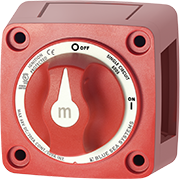Blue Sea Add A Battery Switch and Diagram
The Blue Sea Add A Battery Dual Circuit System is a two-battery management system that simplifies switching between starting battery and house battery for boats. It is simple to use and install, and is designed to be used with alternators rated with a maximum output of 120 Amperes. This article describes two typical single-engine marine alternator charging systems, and details a common dual battery installation.
SINGLE BATTERY BANK, WITH A SINGLE ON/OFF SWITCH
In a common single battery system, both the starting and house loads are powered by a single battery. This results in the risk of draining the battery with a live well, fish finder or other large load. After the epic bite is over, your day could suddenly turn hectic if the battery is too low in voltage to start the engine.
For this single, dual purpose battery system, the voltage and capacity of the battery must be monitored, while limiting the number of accessories used.

Although this ON/OFF switch is simple to operate, keeping the battery charged may be difficult. Charge management is critical, but attending to it constantly detracts from the fun of boating. Failure to get it right could lead to a dead battery and a potentially dangerous situation.
TWO BATTERY BANKS, WITH A 4-POSITION BLUE SEA SELECTOR SWITCH

A common battery switch to handle additional loads beyond starting requirements is by adding a deep cycle battery and a blue sea 4-position battery switch. The 1, 2 and 1+2 Blue Sea switch safely allows loads from live wells, fish finders and GPS to happen.
The single battery system would not tolerate such demand for house loads and starting duty. With a dual battery set up, either battery can be used to start the engines in an emergency by selecting 1+2 position. The battery "one two" switch will also combine batteries for charging or emergency starting. When alternator charging of both batteries is desired, you must move the battery switch to the 1+2 position.
MUST REMEMBER WITH 4-POSITION BLUE SEA SELECTOR SWITCH
There can be a problem if you forget to move out of "1+2" position after charging both batteries. When the boats house loads are being used heavily, both batteries can be drained. If the switch is not moved into the 1 or 2 position, the house loads can over discharge both batteries to a point where engine starting cannot occur. It doesn’t take much to drain both batteries if house loads are heavy. A fully discharged battery is 10.5 volt or 1.75 volts per cell. A fully charged battery is about 2.2 volts per cell.

